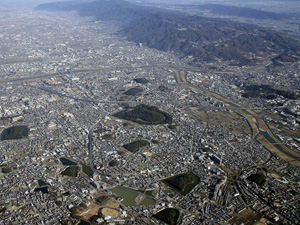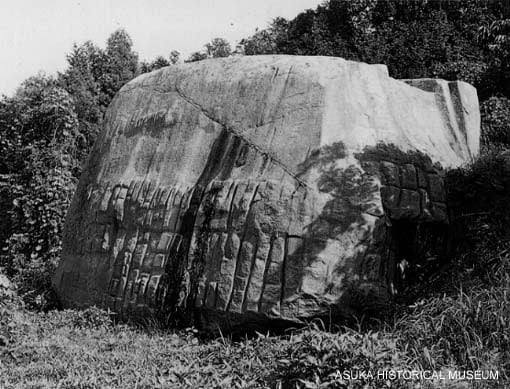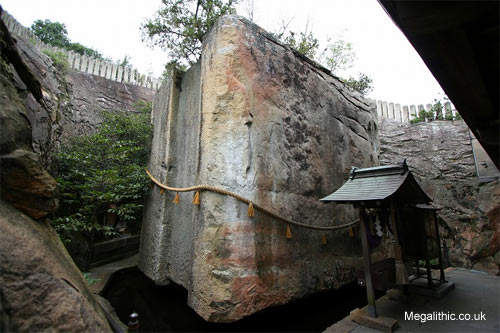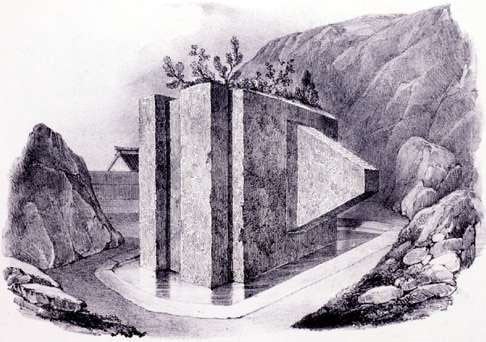Megalithic tombs.
- Furuichi Kofun group - Kansai. Group of 123 megalithic burial structures. 31 of these structures are formed into a keyhole form. These structures were built in the time period between the late 4th and early 6th centuries and are the largest tumulus. Site includes Ôjin-tennô-ryô Kofun - second largest tumulus in Japan, 425 m long.
- Ishibutai Kofun - Kansai. Largest megalithic structure in Japan, a burial of once important person (possibly Soga no Umako). Today here are 30 enormous stones although earlier this structure was larger and covered with soil. Ceiling of the tomb is covered with two giant stones - 60 and 77 tons heavy.
- Kitora Tomb - Kansai. A mound with a tomb for a single, important person. Tomb was created in the time period between the 7th and early 8th centuries AD. On the ceiling of the tomb is drawn star chart but on the walls are painted the oldest known zodiac murals in East Asia.
- Nintoku-ryo Tumulus (Daisen Kofun) - Kansai. Largest ancient tumulus in Japan and whole world, 486 m long and up to 33 m high. Built, possibly, in the middle of the 5th century AD.
- Takamatsuzuka Tomb - Kansai. Burial mound with amazing polychrome frescoes, created in the time period between the end of the 7th century and early 8th century AD. Mound has a diameter of 16 m and is 5 m high. Frescoes are rich with symbolism and show four male followers and four abigails together with Chinese constellations: the Azure Dragon, Black Tortoise, White Tiger, and Vermilion Bird.
Ishibutai-Kofun, an ancient burial tomb located in Asuka village
Built around the beginning of 7th century, scholars believed Ishibutai-Kofun is the burial site of one of the powerful leaders of Soga clan, Soga no Umako. The tomb is 7.8 meters in length, 3.4 meters in width and 4.8 meters in height and is composed of around 30 pieces of granite weighing approximately 2,300 tons.


The term Ishibutai is a combination of two Japanese words, “ishi” and “butai” which mean stone and stage respectively. Folk story says that once upon a time, a fox transformed into a woman and danced above the stones. Another story tells there was this traveling entertainer who used the large tomb stone as a stage in performing.
Admission fee is JPY 250 and the place is open daily from 8:30AM to 5PM. From Kashihara Jingu-mae station or Asuka station, you can take the Nara Kotsu Bus to Ishibutai-mae bus stop to visit the tomb.

- See more at: http://www.rianesleisurefinds.com/nara/#sthash.FuV4fstp.dpuf
===========================
Daisenryo Kofun (Emperor Nintoku's tomb)
This is the largest keyhole-shaped tomb in Japan, measuring approximately 486 meters in length, 249 meters in diameter, 35 meters in height for the back circular mound, 305 meters in width and 33 meters in height for the front mound. Engishiki (the classical compendium of rules) named this tomb Mozu-no-mimihara-no-naka-no-misagi, and currently, the Imperial Household Agency has determined it to be the tomb of Emperor Nintoku, the 16th emperor, and is in charge of managing it. The mound is three-tiered with tsukuridashi (a space for religious ceremonies) on either side of the narrowest part of the tomb, and surrounded by three moats. The current outermost moat was re-dug in the Meiji Era. In the 5th year of the Meiji Era (1872), a rectangular stone coffin placed in a pit-style burial chamber was excavated from the front rectangular mound, and along with it, swords, fine armor, glass pots, dishes, etc. were discovered.
Also, the Sasenmonjyutaikyo (a mirror) and Tahoukantoutachi (a sword with animal engravings), among others, which are said to have been excavated from this tomb are currently in the collection of the Boston Museum of Arts in the United States. In addition, there have been more than ten smaller tombs called Baicho discovered around the tomb. Daisenryo is without a doubt the largest keyhole-shaped tomb in Japan, but there are doubts to other information regarding this tomb; recent excavation projects have revealed shards of Sue ware pots from the tsukuridashi, which would increase the possibility of the tomb being built from mid to late 5th century, raising archaeological controversy about whether it actually is the tomb of Emperor Nintoku. There is an approximately 2.8 kilometer walkway encircling the tomb, which takes an hour to walk around.
Sursa: https://www.osaka-info.jp/en/facilities/cat17/post_238.html
====================================================
What is Mozu-Furuichi Kofungun?
Construction age and composition of the tumulus cluster.
Construction age and composition of the tumulus cluster.
Mozu-Furuichi Kofungun is a group formed of monumental kofun spread across Sakai, Habikino and Fujiidera Cities in southern Osaka. Though divided into two areas ("Mozu" in Sakai and "Furuichi" in Habikino and Fujiidera), they have sufficient integrity and continuity to be treated as a single entity. More than 200 kofun were built within these tumulus cluster between the late 4th century and the early 6th century, and, 89 of these still survive today.
The largest of these tumuli is Nintoku-tenno-ryo Kofun (mound length 486m, the longest in Japan). Next comes Ojin-tenno-ryo Kofun (425m, 2nd longest in Japan), then Richu-tenno-ryo Kofun (365m, 3rd longest), Nisanzai Kofun (290m, joint 8th longest), Nakatsuhimeno-mikoto-ryo Kofun (290m, joint 8th longest) and Chuai-tenno-ryo Kofun (242m), in that order.

▲ Mozu-Furuichi Kofungun
In the whole of Japan, there are nearly 40 kofun with a mound length of 200m or more, and 11 of these are within Mozu-Furuichi Kofungun. No other region of Japan has such a large concentration of massive keyhole-shaped tumuli.
Many of these monumental kofun are surrounded by a series of moats, with smaller mounds called “baicho” (satellite tumuli) arranged on the outside of these.
In terms of their shape, there are 43 keyhole-shaped tumuli (including 12 scallop shell-shaped tumuli), 24 round tumuli and 22 square tumuli in Mozu-Furuichi Kofungun.
===============================================
Masuda no iwafune
The Mysterious Rock Ship
=======================
There is a man-made object atop the mountain, with square holes made in a boulder inferred to weigh 800 tons. What could it be?
益田岩船
Masuda no Iwafune (Rock Ship of Masuda), near the top of Iwafune hill, is the largest carved stone object in the Asuka region. It is a huge boulder inferred to weigh 800 tons, with two square holes opened on the top. Clearly worked by human hands, it is not known who made it, when, or for what purpose.
The true nature of this rock has long been debated. Various theories have emerged, such as its being equipment for ancient people’s astronomical observations, or the pedestal for stone inscriptions, but recently the most favored view is that it was abandoned in its original position in the midst of making it into a stone burial chamber. As there are fissures on the rock’s circumference, it may be that it was abandoned when these were noted during the work.
=========================================================
The mysterious monoliths of Asuka Nara and the Rock Ship of Masuda
The village of Asuka is located in the Takaichi District of the Nara Prefecture in Japan. Asuka is an ancient land with historical interest. It has its origins in the Tumulus Period (250-552 AD), also called Kofun jidai, which means Old Mound period. This era of Japanese history is characterised by a particular type of burial mound that was popular at the time; specifically key shaped earthen mounds surrounded by moats. One of the most unique features of Asuka is the multiple carved granite stones in peculiar shapes in various parts of the region. The largest and most unusual of the carved stones is the Masuda-no-iwafune (the 'rock ship of Masuda').
The stone carving, which stands near the top of a hill in Asuka, is 11 metres in length, 8 metres in width and 4.7 metres in height, and weighs approximately 800 tonnes. The top of has been completely flattened and there are two one-meter square holes carved into it and a ridge line that is parallel to both holes. At the base of the stone are lattice-shaped indentations which are believed to be related to the process that was used by the builders to flatten the sides of the rock.

So what is the nature of this rock and what is its purpose? Who made it, when and why? Unfortunately, there are no definite answers to those questions, but numerous suggestions have been put forward to account for this unique and unusual structure.
In the region in which Masuda no iwafune is found, there are many Buddhist temples and shrines that may suggest the carving was made by Buddhists, perhaps for some kind of religious or ceremonial purpose. However, Masuda no iwafune does not resemble the style or construction of any other Buddhist monument.
Another suggestion comes from the name of the rock itself, which translates to ‘the rock ship of Masuda’. It has been suggested that the stone was carved in commemoration of the building of Masuda Lake, which was once located nearby (now drained and part of Kashiwara City).
Another popular theory is that it was used as an astronomical observation point. Evidence for this perspective comes from the ridge line across the top of the rock which runs parallel to the mountain ridge in Asuka and lines up with the sunset on a certain day of the year called "spring doyou entry", which occurs 13 days after the sectional solar term ‘Pure Brightness’. This day was important in the lunar calendar and for early Japanese agriculture as it signalled the beginning of the agricultural season. However, this perspective has been largely dismissed by scholars who do not recognise it as an ancient astronomical observing station.
Some historians believe that the rock is just the remains of a tomb that was designed for members of the royal family. However, this does not explain the unusual features, such as the square holes on top, nor have any bodies been found. To account for this, some have suggested it was intended as the entrance of a tomb but was unfinished.
Interestingly, Masuda no iwafune bears a similarity to another stone block in Japan – the Ishi-no-Hoden megalith, which is situated in Takasago city. The Ishi-no-Hoden megalith measures 6.45m x 5.7 m x 5.45 m, and has similar ridges on the sides but without any visible holes – although some suggest that they are beneath the trees on the top of the rock.

 Today, Ishi-no-Hoden is a shrine dedicated to the Shinto god Oshiko Jinja, but no one knows who originally built it and why.
Today, Ishi-no-Hoden is a shrine dedicated to the Shinto god Oshiko Jinja, but no one knows who originally built it and why.
Very little is known about the Masuda no iwafune stone carving and definitive evidence is still lacking with regards to who built it and why. The fact that there are so many other stone slabs and structures in the area suggests that the region was inhabited prior to the Tumulus period, but again, there is no proof to support this perspective. In the end, the true origin and purpose of these enigmatic features of ancient Japan may be lost to the pages of history.
By John Black
The stone carving, which stands near the top of a hill in Asuka, is 11 metres in length, 8 metres in width and 4.7 metres in height, and weighs approximately 800 tonnes. The top of has been completely flattened and there are two one-meter square holes carved into it and a ridge line that is parallel to both holes. At the base of the stone are lattice-shaped indentations which are believed to be related to the process that was used by the builders to flatten the sides of the rock.

So what is the nature of this rock and what is its purpose? Who made it, when and why? Unfortunately, there are no definite answers to those questions, but numerous suggestions have been put forward to account for this unique and unusual structure.
In the region in which Masuda no iwafune is found, there are many Buddhist temples and shrines that may suggest the carving was made by Buddhists, perhaps for some kind of religious or ceremonial purpose. However, Masuda no iwafune does not resemble the style or construction of any other Buddhist monument.
Another suggestion comes from the name of the rock itself, which translates to ‘the rock ship of Masuda’. It has been suggested that the stone was carved in commemoration of the building of Masuda Lake, which was once located nearby (now drained and part of Kashiwara City).
Another popular theory is that it was used as an astronomical observation point. Evidence for this perspective comes from the ridge line across the top of the rock which runs parallel to the mountain ridge in Asuka and lines up with the sunset on a certain day of the year called "spring doyou entry", which occurs 13 days after the sectional solar term ‘Pure Brightness’. This day was important in the lunar calendar and for early Japanese agriculture as it signalled the beginning of the agricultural season. However, this perspective has been largely dismissed by scholars who do not recognise it as an ancient astronomical observing station.
Some historians believe that the rock is just the remains of a tomb that was designed for members of the royal family. However, this does not explain the unusual features, such as the square holes on top, nor have any bodies been found. To account for this, some have suggested it was intended as the entrance of a tomb but was unfinished.
Interestingly, Masuda no iwafune bears a similarity to another stone block in Japan – the Ishi-no-Hoden megalith, which is situated in Takasago city. The Ishi-no-Hoden megalith measures 6.45m x 5.7 m x 5.45 m, and has similar ridges on the sides but without any visible holes – although some suggest that they are beneath the trees on the top of the rock.


Very little is known about the Masuda no iwafune stone carving and definitive evidence is still lacking with regards to who built it and why. The fact that there are so many other stone slabs and structures in the area suggests that the region was inhabited prior to the Tumulus period, but again, there is no proof to support this perspective. In the end, the true origin and purpose of these enigmatic features of ancient Japan may be lost to the pages of history.
By John Black
Read more: http://www.ancient-origins.net/ancient-places-asia/mysterious-monoliths-asuka-nara-and-rock-ship-masuda-001415#ixzz3dKB3AqwP
===================================
Ishi-no-Hōden ; Alternative Name: 石の宝殿,Ishi-no-Houden
Sculptured Stone in Honshū
A mysterious dug-out cube monument in a quarry. Known as one of 3 greatest enigmas in Japan. Now worshiped as the god of the Ōshiko jinja shinto shrine. Although the structure of the top is concealed by pine trees, they suspect that there may be 2 holes like Masada-no-Iwafune and Kengoshizuka-kofun. The name of the nearest station is named after this site "Houden".
The German doctor Philipp Franz von Siebold (1796-1866), who entered isolated Japan disguising as a Dutchman, later presented his drawing of Ishi-no-Hōden in volume 1 of his books "NIPPON" (1832).
A mysterious dug-out cube monument in a quarry. Known as one of 3 greatest enigmas in Japan. Now worshiped as the god of the Ōshiko jinja shinto shrine. Although the structure of the top is concealed by pine trees, they suspect that there may be 2 holes like Masada-no-Iwafune and Kengoshizuka-kofun. The name of the nearest station is named after this site "Houden".
The German doctor Philipp Franz von Siebold (1796-1866), who entered isolated Japan disguising as a Dutchman, later presented his drawing of Ishi-no-Hōden in volume 1 of his books "NIPPON" (1832).
===============================================
Site Name: Kengoshi-zuka Kofun ; Alternative Name: 牽牛子塚古墳
A small tumulus, which was supposed to have been in an octagonal pyramid shape. The rock cut chamber inside is divided into 2 rooms.
==========================================================
Sakahuneishi
====================
It may be that those seeking answers are looking at these sites and monuments with a certain degree of 21st century and perhaps Western chauvinism, and that their lack of familiarity with ancient Japanese cultural practices means that they will remain blind to potentially obvious purposes and meanings behind them. Though much of the our understanding today comes from the work of researchers and archaeologists native to Japan, so that explanation may not carry much weight. But archaeology in this part of the world is different from other places. Quickly changing language systems, and an early habit of religiously/politically motivated revisionist history, added to the reluctance of locals to trust outsiders, definitely hinders efforts to bring meaning to these ancient artefacts from a time long gone.
In the end, the true origin and history of these enigmatic features of old-world Japan may be lost to the passage of time. We can learn much from the study of ancient traditions, customs and languages, but not everything survives the long march of the ages.
Sursa: http://mysteriousuniverse.org/2014/02/masuda-no-iwafune-the-ancient-rock-ship-of-asuka-japan/
I love, Japan! - Admin
========================================
==========================================================
=====================================================================

















excelent
RăspundețiȘtergere